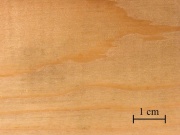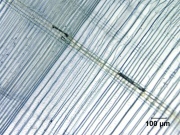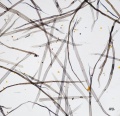Difference between revisions of "Red pine"
m (Text replace - "\[http:\/\/cameo\.mfa\.org\/materials\/fullrecord\.asp\?name=([^\s]+)\s(.*)\]" to "$2") |
|||
| Line 1: | Line 1: | ||
| − | [[File:16_NorwayPine.jpg|thumb|Norway Pine | + | [[File:16_NorwayPine.jpg|thumb|Norway Pine (''Pinus resinosa'')]] |
| − | |||
| − | (''Pinus resinosa'')]] | ||
== Description == | == Description == | ||
| Line 17: | Line 15: | ||
1: Norway pine; ''Pinus resinosa '' | 1: Norway pine; ''Pinus resinosa '' | ||
| − | + | 2: rima; ''Dacrydium cupressinum '' | |
| − | + | 3: Japanese red pine; ''Pinus densiflora'' | |
| − | == | + | == Physical and Chemical Properties == |
| + | 1: 33 ppcf | ||
2: 37 ppcf | 2: 37 ppcf | ||
| − | |||
| − | |||
| − | |||
| − | |||
| − | |||
| − | |||
Paper fiber type: softwood, hard pine. Using transmitted light microscopy, fibers are identified by the presence of large, rectangular fenestriform pits. Pits occur as singles (across the fiber) more than doubles, but both may be present. Dentate ray tracheids are present. Appearance with [[Graff "C" stain]]: varies with pulping and bleaching. Average dimensions of fibers: length 3.4mm, width 30-40μm. Common pulping method: [[kraft process|kraft]] and [[sulfite process|sulfite]]. | Paper fiber type: softwood, hard pine. Using transmitted light microscopy, fibers are identified by the presence of large, rectangular fenestriform pits. Pits occur as singles (across the fiber) more than doubles, but both may be present. Dentate ray tracheids are present. Appearance with [[Graff "C" stain]]: varies with pulping and bleaching. Average dimensions of fibers: length 3.4mm, width 30-40μm. Common pulping method: [[kraft process|kraft]] and [[sulfite process|sulfite]]. | ||
| Line 42: | Line 35: | ||
</gallery> | </gallery> | ||
| − | + | ==Resources and Citations== | |
| − | == | ||
* G.S.Brady, ''Materials Handbook'', McGraw-Hill Book Co., New York, 1971 Comment: p. 614 | * G.S.Brady, ''Materials Handbook'', McGraw-Hill Book Co., New York, 1971 Comment: p. 614 | ||
| Line 49: | Line 41: | ||
* ''Dictionary of Building Preservation'', Ward Bucher, ed., John Wiley & Sons, Inc., New York City, 1996 | * ''Dictionary of Building Preservation'', Ward Bucher, ed., John Wiley & Sons, Inc., New York City, 1996 | ||
| − | * | + | * Northern Pine Manufacturers: air-dry weight = 33 pcf |
* ''The American Heritage Dictionary'' or ''Encarta'', via Microsoft Bookshelf 98, Microsoft Corp., 1998 | * ''The American Heritage Dictionary'' or ''Encarta'', via Microsoft Bookshelf 98, Microsoft Corp., 1998 | ||
Revision as of 12:48, 3 October 2022
Description
1) A common evergreen tree, Pinus resinosa, native to northeastern North America. Red pine has a light reddish wood with a fine grain. The strong, hard wood is used for flooring, millwork, and kraft pulp. Lumber production of red pine in the United States peaked about 1889.
2) The primary timber tree, Dacrydium cupressinum, of New Zealand. Red pine has a reddish brown wood with a straight grain. It is used for furniture, millwork, and kraft pulp.
3): A decorative evergreen, Pinus densiflora, native to Japan. The Japanese red pine is primary used for landscaping.
Synonyms and Related Terms
1: Norway pine; Pinus resinosa
2: rima; Dacrydium cupressinum
3: Japanese red pine; Pinus densiflora
Physical and Chemical Properties
1: 33 ppcf
2: 37 ppcf
Paper fiber type: softwood, hard pine. Using transmitted light microscopy, fibers are identified by the presence of large, rectangular fenestriform pits. Pits occur as singles (across the fiber) more than doubles, but both may be present. Dentate ray tracheids are present. Appearance with Graff "C" stain: varies with pulping and bleaching. Average dimensions of fibers: length 3.4mm, width 30-40μm. Common pulping method: kraft and sulfite.
Additional Images
Resources and Citations
- G.S.Brady, Materials Handbook, McGraw-Hill Book Co., New York, 1971 Comment: p. 614
- Dictionary of Building Preservation, Ward Bucher, ed., John Wiley & Sons, Inc., New York City, 1996
- Northern Pine Manufacturers: air-dry weight = 33 pcf
- The American Heritage Dictionary or Encarta, via Microsoft Bookshelf 98, Microsoft Corp., 1998
- Marja-Sisko Ilvessalo-Pfäffli. Fiber Atlas: Identification of Papermaking Fibers (Springer Series in Wood Science). Springer, 1995.
- Walter Rantanen. "Fiber ID Course." Integrated Paper Services. June 2013. Lecture.





